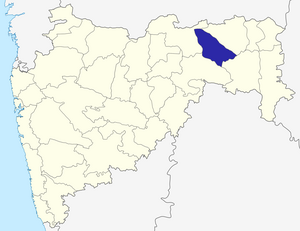Wardha (district)
| Wardha district | |
|---|---|

|
|
| State | Maharashtra |
| Division : | Nagpur |
| Administrative headquarters : | Wardha |
| Area : | 6,309 km² |
| Residents : | 1,300,774 |
| Population density : | 206 inhabitants / km² |
| Website : | wardha.nic.in |
The Wardha district ( Marathi : वर्धा जिल्हा ) is one of 35 districts of the state of Maharashtra in India .
The city of Wardha is the administrative seat of the district that belongs to the Nagpur division and the Vidarbha region . The last census in 2011 showed a total population of 1,300,774 people.
history
From pre-Christian times to the year 1345, the area - like the entire region - was ruled by various Buddhist and Hindu rulers. The first state known by name was the Maurya Empire , the last non-Muslim dynasty were the Gond. After decades of military clashes with Muslim rulers in northern India, it was occupied by Muslim soldiers in 1345. Thereafter, various Muslim dynasties ruled until 1724 (Sultanate of Delhi, Bahmani, Dekkan sultanates and the Great Mughals). In 1739 the area became independent as Nagpur Kingdom as part of the Hindu Marathi Empire. After the Marathas were defeated by the British in 1818, it became part of the British Empire as an independent state. After the last ruler of the kingdom died in 1853, the kingdom of Nagpur was incorporated into the British administrative region of Central Provinces (Central Provinces and Berar since 1903). In 1862 Wardha became a separate district after it was separated from Nagpur District. With the independence of India in 1947 and the reorganization of the country, it became part of the new state of Madhya Pradesh in 1950 . In 1956 this Indian state was divided and the area came to the state of Bombay. This state was also dissolved in 1960 and the Wardha district became part of the new Indian state of Maharashtra.
population
The last census in 2011 counted 1,300,774 inhabitants. Of these, 668,385 were men (51.38 percent) and 632,389 women. In 2011, 188,830 (14.5 percent) belonged to the Dalit and 149,507 (11.5 percent) to the Adivasi . Of the total number of residents, 423,300 people (32.54 percent) lived in urban areas in 2011. Thus more than two thirds of the population lived in the country. The majority of the population of Wardha District speaks Marathi . There are 1,004 inhabited villages throughout the district.
Population of the district by confession
A clear vast majority of the population are Hindus. The Buddhists are a significant minority. There is also a numerically significant minority of Muslims. The following table shows the exact religious composition of the population:
| year | Buddhists | Christians | Hindus | Jainas | Muslims | Sikhs | Other | not specified | Total | |||||||||
|---|---|---|---|---|---|---|---|---|---|---|---|---|---|---|---|---|---|---|
| number | % | number | % | number | % | number | % | number | % | number | % | number | % | number | % | Residents | % | |
| 2001 | 169,579 | 13.71% | 2,559 | 0.21% | 1.006.235 | 81.36% | 5,990 | 0.48% | 47,605 | 3.85% | 1,825 | 0.15% | 1,930 | 0.16% | 1,013 | 0.08% | 1,236,736 | 100.00% |
| Source: 2001 India Census | ||||||||||||||||||
Population development
As everywhere in India, the population in Wardha district has been growing rapidly for decades. The increase slowed down in the years 2001–2011, however, and was only slightly over 5 percent (5.18%). In these ten years the population increased by around 60,000 people. The following table shows the exact numbers:

Significant places
The most populous town in the district is the main town Wardha. Other major cities with a population of more than 20,000 people are Hinganghat , Arvi, Pulgaon, Pipri and Sindi Turf Hindnagar.

Web links
- District website
- [1] - Wardha district map
- [2] - Wardha District
- [3] - Some background information about the district
- [4] - Economy, nature and sights